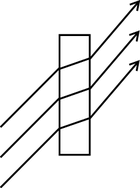The color of the objects we see in the natural world is a result of the way objects interact with light. When a light wave strikes an object, it can be absorbed, reflected, or refracted by the object. All objects have a degree of reflection and absorption.
In the natural world, light can also be transmitted by an object. That is, light can pass through an object with no effect (an x-ray, for example). These types of light, however, are not represented in Maya because they have no visual effect.
Absorption
 |
Light stops at the object and does not reflect or refract. Objects appear dark or opaque. Example: wood. |
Reflection on a smooth surface
 |
Light bounces off the surface of a material at an angle equal to the angle of the incoming light wave. Example: mirrors or glass. See also Diffuse, Specular, and Glossy reflection . |
Scatter (Reflection on a rough surface)
 |
Light waves bounce off at many of angles because the surface is uneven. Example: the earth (that’s why the sky is blue). See also Types of reflection (Diffuse, Specular, and Glossy). |
Refraction
 |
Light goes through the object and bends at an angle. Example: diamond (greater angle) or water (lesser angle) See also Types of refraction (Diffuse, Specular, and Glossy). |